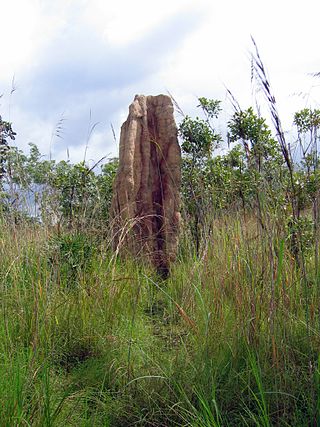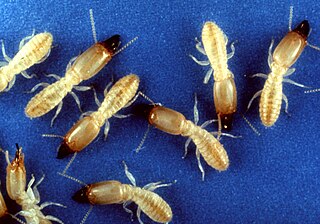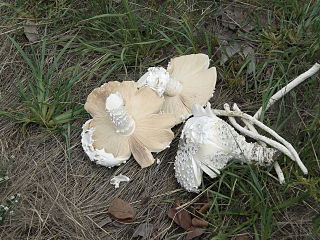
Termites are a group of detritophagous eusocial insects which consume a wide variety of decaying plant material, generally in the form of wood, leaf litter, and soil humus. They are distinguished by their moniliform antennae and the soft-bodied and often unpigmented worker caste for which they have been commonly termed "white ants"; however, they are not ants, to which they are distantly related. About 2,972 extant species are currently described, 2,105 of which are members of the family Termitidae.

Natamycin, also known as pimaricin, is an antifungal medication used to treat fungal infections around the eye. This includes infections of the eyelids, conjunctiva, and cornea. It is used as eyedrops. Natamycin is also used in the food industry as a preservative.

Mound-building termites are a group of termite species that live in mounds which are made of a combination of soil, termite saliva and dung. These termites live in Africa, Australia and South America. The mounds sometimes have a diameter of 30 metres (98 ft). Most of the mounds are in well-drained areas. Termite mounds usually outlive the colonies themselves. If the inner tunnels of the nest are exposed it is usually dead. Sometimes other colonies, of the same or different species, occupy a mound after the original builders' deaths.

Reticulitermes flavipes, the eastern subterranean termite, is the most common termite found in North America. These termites are the most economically important wood destroying insects in the United States and are classified as pests. They feed on cellulose material such as the structural wood in buildings, wooden fixtures, paper, books, and cotton. A mature colony can range from 20,000 workers to as high as 5 million workers and the primary queen of the colony lays 5,000 to 10,000 eggs per year to add to this total.

The Macrotermitinae, the fungus-growing termites, constitute a subfamily of the family Termitidae that is only found within the Old World tropics.

Streptomyces natalensis is a bacterial species in the genus Streptomyces.

Macrotermes bellicosus is a species of Macrotermes. The queens are the largest amongst known termites, measuring about 4.2 inches (110 mm) long when physogastric. The workers average 0.14 in (3.6 mm) in length and soldiers are slightly larger. Bellicosus means "combative" in Latin. The species is a member of a genus indigenous to Africa and South-East Asia.

Termitomyces schimperi is a large mushroom associated with the termite species Macrotermes michaelseni. It grows in the northern part of Southern Africa, from northern Namibia up to Democratic Republic of Congo (DRC), eastwards to Malawi and Mozambique, and westwards to Ivory Coast.

Termitotrox cupido is a species of scarab beetle in the subfamily Termitotroginae. It was first described by Munetoshi Maruyama in 2012, having been discovered living inside a nest of the termite Hypotermes makhamensis in Cambodia. It is a tiny, blind and flightless insect.

Macrotermes michaelseni is a species of termite in the family Termitidae, found in sub-Saharan Africa. It is associated with the fungus Termitomyces schimperi.

Falcataria falcata, commonly known as the Moluccan albizia, is a species of fast-growing tree in the family Fabaceae. It is native to the Maluku Islands, New Guinea, the Bismarck Archipelago, and the Solomon Islands. It is cultivated for timber throughout South Asian and Southeast Asian countries. This tree is considered to be invasive in Hawaii, American Samoa and several other island nations in the Pacific and Indian Oceans. It reaches about 30 m (100 ft) tall in nature, and has a massive trunk and an open crown.

Macrotermes is a genus of termites belonging to the subfamily Macrotermitinae and widely distributed throughout Africa and South-East Asia. Well-studied species include Macrotermes natalensis and M. bellicosus.
Streptomyces termitum is a bacterium species from the genus of Streptomyces which has been isolated from termites.
Macrotermes convulsionarius is a species of termite of the family Termitidae. It is native to India and Sri Lanka. Soldiers are very large with well developed mandibles. It is a major pest of many wood works in buildings. Flagellated bacteria such as Bacillus, Acinitobacter, Salmonella, Enterobacter, and Enterococcus are found abundant in gut of M. convulsionarius.
Dysgonomonas macrotermitis is a Gram-negative, facultatively anaerobic and non-motile bacterium from the genus of Dysgonomonas which has been isolated from the hindgut from the termite Macrotermes barneyi.

Macrotermes carbonarius, also known as Kongkiak in Malay, is a large black species of fungus-growing termite in the genus Macrotermes. It is one of the most conspicuous species of Macrotermes found in the Indomalayan tropics, forming large foraging trails in the open that can extend several metres in distance. M. carbonarius is a highly aggressive species with the soldiers possessing large curving mandibles that easily break skin. It is found in Cambodia, Malaysia, Myanmar, Singapore, Thailand and Vietnam.
Streptomyces fractus is a bacterium species from the genus of Streptomyces which has been isolated from the termite Amitermes hastatus from the Tygerberg Nature Reserve in South Africa.

Stenaelurillus guttiger is a species of jumping spider in the genus Stenaelurillus that is native to southern Africa. It was first described in 1901 by Eugène Simon based on examples found in South Africa, and subsequently also identified in Botswana, Mozambique and Zimbabwe. Initially allocated to the genus Aelurillus, the species was moved to its current genus in 1974. The spider is medium-sized, with a carapace that is between 2.0 and 2.75 mm long and an abdomen that is between 1.8 and 2.9 mm long. It is dark brown or brown, and has a pattern of white hairs on both the abdomen and carapace and a pattern of two stripes on the carapace. The abdomen has a white pattern of straight and V-shaped stripes and spots which varies between specimens. The colouring of the clypeus and legs can also range from yellow to dark brown depending on the particular example. It is distinguished from other species in the genus by the design of its sexual organs. The male has an embolus that is short and crab like. The female has a flat plate epigyne with widely separated copulatory openings and insemination ducts and a deep narrow pocket. Stenaelurillusguttiger feeds on termites, particularly Macrotermes and Odontotermes.

Macrotermes natalensis is a fungus-growing termite species that belongs to the genus Macrotermes. This species is associated with the Termitomyces fungal genus. M. natalensis has domesticated Termitomyces to produce food for the colony. Both termite species- fungal genus- are obligate and mutually beneficial where termite relies on the fungus to break down for plant materiel and nutrient resource. In contrast, the fungal species obtain plant material and optimal conditions for growth.

Odontotermes is a termite genus belonging to subfamily Macrotermitinae, which is native to the Old World. They are most destructive in wooden homes, and are agricultural pests in the tropics and subtropics of Africa and Asia. It is the most diverse termite genus in Africa, with 78 species recorded.













